Nissim Kanekar
Nissim Kanekar | |
|---|---|
| Born | 11 September 1973 Shanti Swarup Bhatnagar Prize |
| Scientific career | |
| Fields | |
| Institutions | |
Nissim Kanekar (born 11 September 1973) is an Indian astrophysicist, cosmologist and a professor at National Centre for Radio Astrophysics of Tata Institute of Fundamental Research. Known for his research on the evolution of the electron proton mass ratio, Kanekar is a member of the International Astronomical Union and a recipient of Swarna Jayathi Fellowship of the Department of Science and Technology. The Council of Scientific and Industrial Research, the apex agency of the Government of India for scientific research, awarded him the Shanti Swarup Bhatnagar Prize for Science and Technology, one of the highest Indian science awards, for his contributions to physical sciences in 2017.[1][note 1]
Biography

Nissim Kanekar, born on 11 September 1973 in
Legacy and honours

One of the principal contributions of Kanekar was the establishment of observational bounds for the study of the evolution of the electron proton mass ratio.[5] He has also done reportedly notable work on the fine structure constant over cosmological time scales.[6] He was one among the group of astronomers who observed a pair of distant Milky Way-like galaxies in early 2017[7] which has since been detailed in a paper published by the scientists.[8] His studies have been documented by way of a number of articles[9] and ResearchGate, an online article repository of scientific articles, has listed 115 of them.[10][note 2] He has also delivered several lectures on astronomy which include a series of lectures delivered at Indian Institute of Science Education and Research, Mohali in 2014.[11]
Kanekar received the URSI Young Scientist Award of the
Selected bibliography
- Nissim Kanekar (2011). "Constraining changes in the proton-electron mass ratio with inversion and rotational lines". Astrophysical Journal Letters. 728 (1): L12. S2CID 119230502.
- Nirupam Roy, N. Kanekar, Robert Braun, Jayaram N. Chengalur (2013). "The temperature of the diffuse HI in the Milky Way I: High resolution HI 21 cm absorption studies". MNRAS. 436 (3): 2352–2365. S2CID 119222770.)
{{cite journal}}: CS1 maint: multiple names: authors list (link - Nissim Kanekar (2016). "First Connection between Cold Gas in Emission and Absorption: CO Emission from a Galaxy-Quasar Pair". Astrophysical Journal Letters. 820 (2): L39. S2CID 119075508.
See also
Notes
References
- ^ "View Bhatnagar Awardees". Shanti Swarup Bhatnagar Prize. 11 November 2017. Retrieved 11 November 2017.
- ^ "Nissim Kanekar on NCRA". National Centre for Radio Astrophysics. 2 November 2017. Retrieved 2 November 2017.
- ^ a b c d "Biographical Information-Kanekar" (PDF). National Centre for Radio Astrophysics. 31 October 2017. Retrieved 31 October 2017.
- ^ a b "Ramanujan Fellows" (PDF). SERB. 2 November 2017. Retrieved 2 November 2017.
- ^ "Brief Profile of the Awardee". Shanti Swarup Bhatnagar Prize. 21 October 2017. Retrieved 21 October 2017.
- ^ "Handbook of Shanti Swarup Bhatnagar Prize Winners" (PDF). Council of Scientific and Industrial Research. 17 October 2017. Archived from the original (PDF) on 4 March 2016. Retrieved 17 October 2017.
- ^ "Peek into how galaxies like Milky Way looked 12 billion years ago". Indian Express. 20 April 2017. Retrieved 3 November 2017.
- S2CID 34680077.)
{{cite journal}}: CS1 maint: multiple names: authors list (link) CS1 maint: numeric names: authors list (link - ^ "arXiv.org Search Results". Cornell University. 31 October 2017. Retrieved 31 October 2017.
- ^ "On ResearchGate". 17 October 2017. Retrieved 17 October 2017.
- ^ "Lectures at IISER-Mohali, October 2014". NCRA. 3 November 2017. Retrieved 3 November 2017.
- ^ "Swarna Jayanthi Fellowship" (PDF). Department of Science and Technology. 2 November 2017. Retrieved 2 November 2017.
- ^ "10 scientists receive Shanti Swarup Bhatnagar Prize". The Hindu. 26 September 2017. Retrieved 11 November 2017.
- ^ "Kanekar on IAU". International Astronomical Union. 2 November 2017. Retrieved 2 November 2017.
- ^ "Infosys Prize - Laureates 2022 - Nissim Kanekar".
Further reading
- Nissim Kanekar (3 November 2017). "Fundamentals of Radio Astronomy" (Lecture (full text)). National Centre For Radio Astrophysics. Retrieved 3 November 2017.
- Nissim Kanekar (3 November 2017). "Science at Radio Frequencies" (Lecture (full text)). National Centre For Radio Astrophysics. Retrieved 3 November 2017.
External links
- "Author profile". Science Mag. 1 November 2017. Retrieved 1 November 2017.
- Barthel, W.; Markwardt, F. (1 November 2017). "Author profile on PubMed". Biochemical Pharmacology. 24 (20): 1903–4. PMID 20.
- Nissim Kanekar (June 2016). "Lecture at National Central University". 中央大學天文研究所台達電子基金會. Retrieved 3 November 2017.
